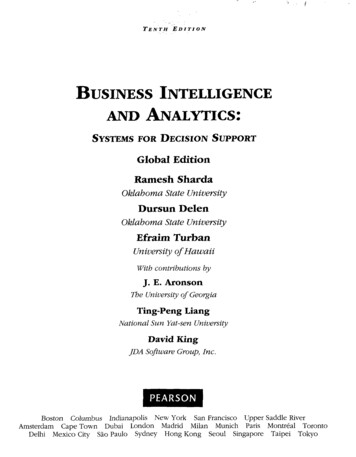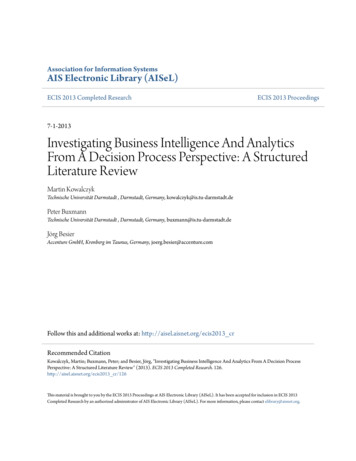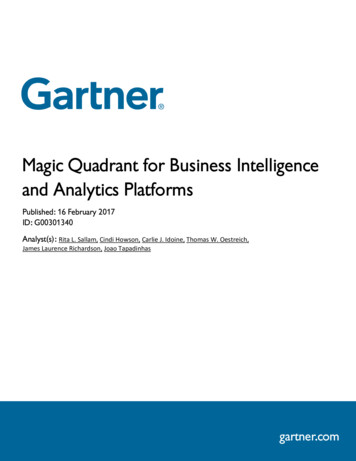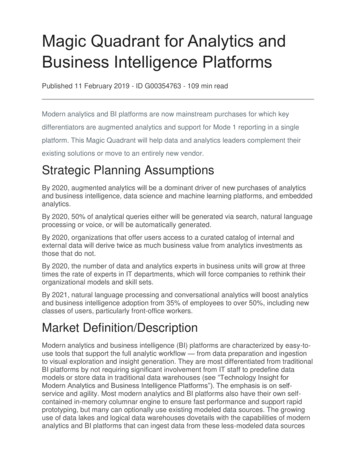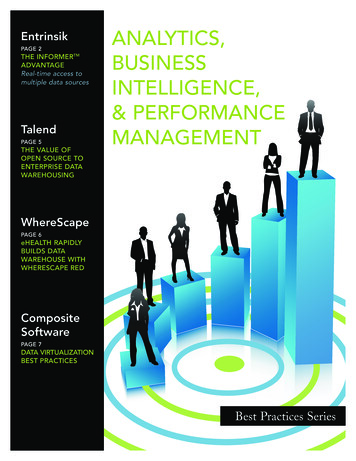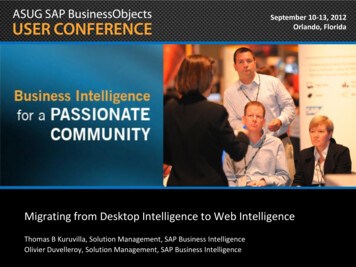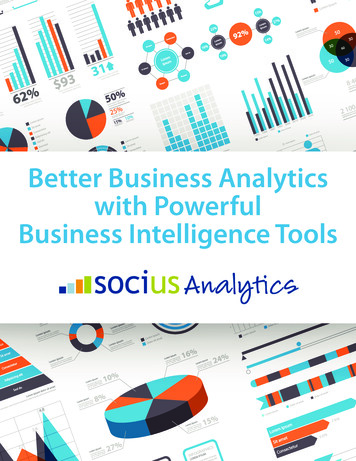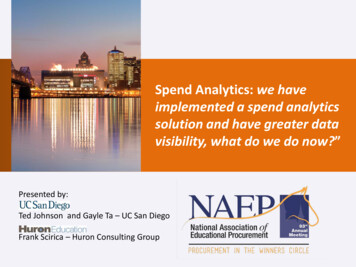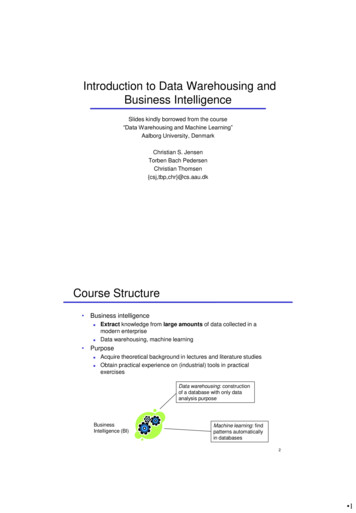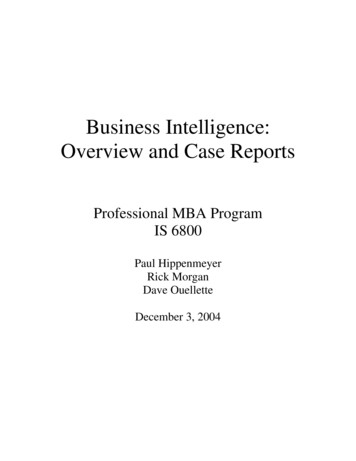
Transcription
SPECIAL ISSUE: BUSINESS INTELLIGENCE RESEARCHBUSINESS INTELLIGENCE AND ANALYTICS:FROM BIG DATA TO BIG IMPACTHsinchun ChenEller College of Management, University of Arizona,Tucson, AZ 85721 U.S.A. {hchen@eller.arizona.edu}Roger H. L. ChiangCarl H. Lindner College of Business, University of Cincinnati,Cincinnati, OH 45221-0211 U.S.A. {chianghl@ucmail.uc.edu}Veda C. StoreyJ. Mack Robinson College of Business, Georgia State University,Atlanta, GA 30302-4015 U.S.A. {vstorey@gsu.edu}Business intelligence and analytics (BI&A) has emerged as an important area of study for both practitionersand researchers, reflecting the magnitude and impact of data-related problems to be solved in contemporarybusiness organizations. This introduction to the MIS Quarterly Special Issue on Business Intelligence Researchfirst provides a framework that identifies the evolution, applications, and emerging research areas of BI&A.BI&A 1.0, BI&A 2.0, and BI&A 3.0 are defined and described in terms of their key characteristics andcapabilities. Current research in BI&A is analyzed and challenges and opportunities associated with BI&Aresearch and education are identified. We also report a bibliometric study of critical BI&A publications,researchers, and research topics based on more than a decade of related academic and industry publications.Finally, the six articles that comprise this special issue are introduced and characterized in terms of theproposed BI&A research framework.Keywords: Business intelligence and analytics, big data analytics, Web 2.0IntroductionBusiness intelligence and analytics (BI&A) and the relatedfield of big data analytics have become increasingly importantin both the academic and the business communities over thepast two decades. Industry studies have highlighted thissignificant development. For example, based on a survey ofover 4,000 information technology (IT) professionals from 93countries and 25 industries, the IBM Tech Trends Report(2011) identified business analytics as one of the four majortechnology trends in the 2010s. In a survey of the state ofbusiness analytics by Bloomberg Businessweek (2011), 97percent of companies with revenues exceeding 100 millionwere found to use some form of business analytics. A reportby the McKinsey Global Institute (Manyika et al. 2011) predicted that by 2018, the United States alone will face a shortage of 140,000 to 190,000 people with deep analytical skills,as well as a shortfall of 1.5 million data-savvy managers withthe know-how to analyze big data to make effective decisions.Hal Varian, Chief Economist at Google and emeritus professor at the University of California, Berkeley, commented onthe emerging opportunities for IT professionals and studentsin data analysis as follows:MIS Quarterly Vol. 36 No. 4, pp. 1165-1188/December 20121165
Chen et al./Introduction: Business Intelligence ResearchSo what’s getting ubiquitous and cheap? Data. Andwhat is complementary to data? Analysis. So myrecommendation is to take lots of courses about howto manipulate and analyze data: databases, machinelearning, econometrics, statistics, visualization, andso on.1The opportunities associated with data and analysis in different organizations have helped generate significant interestin BI&A, which is often referred to as the techniques, technologies, systems, practices, methodologies, and applicationsthat analyze critical business data to help an enterprise betterunderstand its business and market and make timely businessdecisions. In addition to the underlying data processing andanalytical technologies, BI&A includes business-centricpractices and methodologies that can be applied to varioushigh-impact applications such as e-commerce, market intelligence, e-government, healthcare, and security.This introduction to the MIS Quarterly Special Issue onBusiness Intelligence Research provides an overview of thisexciting and high-impact field, highlighting its many challenges and opportunities. Figure 1 shows the key sectionsof this paper, including BI&A evolution, applications, andemerging analytics research opportunities. We then reporton a bibliometric study of critical BI&A publications,researchers, and research topics based on more than a decadeof related BI&A academic and industry publications. Education and program development opportunities in BI&A arepresented, followed by a summary of the six articles thatappear in this special issue using our research framework.The final section concludes the paper.BI&A Evolution: Key Characteristicsand CapabilitiesThe term intelligence has been used by researchers inartificial intelligence since the 1950s. Business intelligencebecame a popular term in the business and IT communitiesonly in the 1990s. In the late 2000s, business analytics wasintroduced to represent the key analytical component in BI(Davenport 2006). More recently big data and big dataanalytics have been used to describe the data sets and analytical techniques in applications that are so large (fromterabytes to exabytes) and complex (from sensor to socialmedia data) that they require advanced and unique data1“Hal Varian Answers Your Questions,” February 25, 2008 -answers-your-questions/).1166MIS Quarterly Vol. 36 No. 4/December 2012storage, management, analysis, and visualization technologies. In this article we use business intelligence and analytics (BI&A) as a unified term and treat big data analytics asa related field that offers new directions for BI&A research.BI&A 1.0As a data-centric approach, BI&A has its roots in the longstanding database management field. It relies heavily onvarious data collection, extraction, and analysis technologies(Chaudhuri et al. 2011; Turban et al. 2008; Watson andWixom 2007). The BI&A technologies and applicationscurrently adopted in industry can be considered as BI&A 1.0,where data are mostly structured, collected by companiesthrough various legacy systems, and often stored in commercial relational database management systems (RDBMS). Theanalytical techniques commonly used in these systems,popularized in the 1990s, are grounded mainly in statisticalmethods developed in the 1970s and data mining techniquesdeveloped in the 1980s.Data management and warehousing is considered the foundation of BI&A 1.0. Design of data marts and tools forextraction, transformation, and load (ETL) are essential forconverting and integrating enterprise-specific data. Databasequery, online analytical processing (OLAP), and reportingtools based on intuitive, but simple, graphics are used toexplore important data characteristics. Business performancemanagement (BPM) using scorecards and dashboards helpanalyze and visualize a variety of performance metrics. Inaddition to these well-established business reporting functions, statistical analysis and data mining techniques areadopted for association analysis, data segmentation andclustering, classification and regression analysis, anomalydetection, and predictive modeling in various business applications. Most of these data processing and analytical technologies have already been incorporated into the leading commercial BI platforms offered by major IT vendors includingMicrosoft, IBM, Oracle, and SAP (Sallam et al. 2011).Among the 13 capabilities considered essential for BI platforms, according to the Gartner report by Sallam et al. (2011),the following eight are considered BI&A 1.0: reporting,dashboards, ad hoc query, search-based BI, OLAP, interactivevisualization, scorecards, predictive modeling, and datamining. A few BI&A 1.0 areas are still under active development based on the Gartner BI Hype Cycle analysis foremerging BI technologies, which include data mining workbenchs, column-based DBMS, in-memory DBMS, and realtime decision tools (Bitterer 2011). Academic curricula inInformation Systems (IS) and Computer Science (CS) often
Chen et al./Introduction: Business Intelligence ResearchFigure 1. BI&A Overview: Evolution, Applications, and Emerging Researchinclude well-structured courses such as database managementsystems, data mining, and multivariate statistics.BI&A 2.0Since the early 2000s, the Internet and the Web began to offerunique data collection and analytical research and development opportunities. The HTTP-based Web 1.0 systems,characterized by Web search engines such as Google andYahoo and e-commerce businesses such as Amazon andeBay, allow organizations to present their businesses onlineand interact with their customers directly. In addition toporting their traditional RDBMS-based product informationand business contents online, detailed and IP-specific usersearch and interaction logs that are collected seamlesslythrough cookies and server logs have become a new goldmine for understanding customers’ needs and identifying newbusiness opportunities. Web intelligence, web analytics, andthe user-generated content collected through Web 2.0-basedsocial and crowd-sourcing systems (Doan et al. 2011;O’Reilly 2005) have ushered in a new and exciting era ofBI&A 2.0 research in the 2000s, centered on text and webanalytics for unstructured web contents.An immense amount of company, industry, product, andcustomer information can be gathered from the web andorganized and visualized through various text and web miningtechniques. By analyzing customer clickstream data logs,web analytics tools such as Google Analytics can provide atrail of the user’s online activities and reveal the user’sbrowsing and purchasing patterns. Web site design, productplacement optimization, customer transaction analysis, marketstructure analysis, and product recommendations can beaccomplished through web analytics. The many Web 2.0applications developed after 2004 have also created an abundance of user-generated content from various online socialmedia such as forums, online groups, web blogs, social networking sites, social multimedia sites (for photos and videos),and even virtual worlds and social games (O’Reilly 2005). Inaddition to capturing celebrity chatter, references to everydayevents, and socio-political sentiments expressed in thesemedia, Web 2.0 applications can efficiently gather a largevolume of timely feedback and opinions from a diversecustomer population for different types of businesses.Many marketing researchers believe that social mediaanalytics presents a unique opportunity for businesses to treatthe market as a “conversation” between businesses andcustomers instead of the traditional business-to-customer,one-way “marketing” (Lusch et al. 2010). Unlike BI&A 1.0technologies that are already integrated into commercialenterprise IT systems, future BI&A 2.0 systems will requirethe integration of mature and scalable techniques in textmining (e.g., information extraction, topic identification,opinion mining, question-answering), web mining, socialnetwork analysis, and spatial-temporal analysis with existingDBMS-based BI&A 1.0 systems.MIS Quarterly Vol. 36 No. 4/December 20121167
Chen et al./Introduction: Business Intelligence ResearchExcept for basic query and search capabilities, no advancedtext analytics for unstructured content are currently considered in the 13 capabilities of the Gartner BI platforms.Several, however, are listed in the Gartner BI Hype Cycle,including information semantic services, natural languagequestion answering, and content/text analytics (Bitterer 2011).New IS and CS courses in text mining and web mining haveemerged to address needed technical training.BI&A 3.0Table 1 summarizes the key characteristics of BI&A 1.0, 2.0,and 3.0 in relation to the Gartner BI platforms core capabilities and hype cycle.The decade of the 2010s promises to be an exciting one forhigh-impact BI&A research and development for both industry and academia. The business community and industry havealready taken important steps to adopt BI&A for their needs.The IS community faces unique challenges and opportunitiesin making scientific and societal impacts that are relevant andlong-lasting (Chen 2011a). IS research and education programs need to carefully evaluate future directions, curricula,and action plans, from BI&A 1.0 to 3.0.Whereas web-based BI&A 2.0 has attracted active researchfrom academia and industry, a new research opportunity inBI&A 3.0 is emerging. As reported prominently in anOctober 2011 article in The Economist (2011), the number ofmobile phones and tablets (about 480 million units) surpassedthe number of laptops and PCs (about 380 million units) forthe first time in 2011. Although the number of PCs in usesurpassed 1 billion in 2008, the same article projected that thenumber of mobile connected devices would reach 10 billionin 2020. Mobile devices such as the iPad, iPhone, and othersmart phones and their complete ecosystems of downloadableapplicationss, from travel advisories to multi-player games,are transforming different facets of society, from education tohealthcare and from entertainment to governments. Othersensor-based Internet-enabled devices equipped with RFID,barcodes, and radio tags (the “Internet of Things”) areopening up exciting new steams of innovative applications.The ability of such mobile and Internet-enabled devices tosupport highly mobile, location-aware, person-centered, andcontext-relevant operations and transactions will continue tooffer unique research challenges and opportunities throughoutthe 2010s. Mobile interface, visualization, and HCI(human–computer interaction) design are also promisingresearch areas. Although the coming of the Web 3.0 (mobileand sensor-based) era seems certain, the underlying mobileanalytics and location and context-aware techniques forcollecting, processing, analyzing and visualizing such largescale and fluid mobile and sensor data are still unknown.Several global business and IT trends have helped shape pastand present BI&A research directions. International travel,high-speed network connections, global supply-chain, andoutsourcing have created
Business intelligence and analytics (BI&A) has emerged as an important area of study for both practitioners and researchers, reflecting the magnitude and impact of data-related problems to be solved in contemporary business organizations. This introduc tion to the MIS Quarterly Special Issue on Business Intelligence Research first provides a framework that identifies the evolution .

